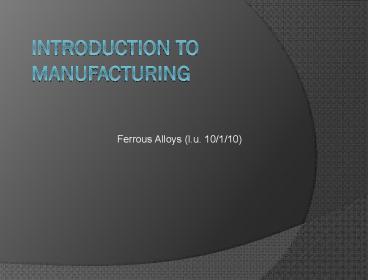Introduction to Manufacturing PowerPoint PPT Presentation
Title: Introduction to Manufacturing
1
Introduction to Manufacturing
- Ferrous Alloys (l.u. 10/1/10)
2
Ferrous Metals and Alloys
- Contain IRON as their base metal.
- second most abundant element in Earths crust
(5). - Relatively inexpensive.
Relative cost per unit Volume (Kalpakjian Schmid, 2006) Relative cost per unit Volume (Kalpakjian Schmid, 2006) Relative cost per unit Volume (Kalpakjian Schmid, 2006) Relative cost per unit Volume (Kalpakjian Schmid, 2006) Relative cost per unit Volume (Kalpakjian Schmid, 2006)
Carbon Steel Copper Nickel Silver Gold
1 5-6X 35X 600X 60,000X
3
Three materials used in Steel
- Iron ore - pelletized metal
- Coke - for heat producing carbon monoxide
which reduces iron-oxide to iron (removes oxygen) - Limestone - combines with impurities which
floats to surface (slag)
4
Common Terms
- Pig Iron- hot metal, molten metal used in making
iron and steels - Ingot- molten metal to solid form ready for
rolling/forging Inefficient! - Continuous Casting become most popular
steel-making technique
5
Three Types of Steel Ingots
- Killed Steel- steel is fully deoxidized oxygen
is removed and porosity is eliminated (consistent
mechanical and chemical properties) - Semi-Killed Steel- partially deoxidized steel
contains some porosity (economical) - Rimmed Steel- low carbon content, porosity
(blowholes), lower quality steel (requires
inspection)
6
Refining
- Removal of impurities (Trace Elements)
7
Refining
- Used to create higher quality steels
- Improves uniformity and consistency in
composition - Removing impurities, inclusions, other elements
- Adding various elements
8
Inclusions? Good or bad?
Free-machining steels are basically carbon
steels that have been modified by an addition of
sulfur, lead, bismuth, selenium, tellurium, or
phosphorous plus sulfur to enhance machinability.
Sulfur combines with manganese to form soft
manganese sulfide inclusions. These, in turn,
serve as chip-breaking discontinuities within the
structure. The inclusions also provide a build-in
lubricant that prevents formation of a build-up
edge on the cutting tool and imparts an improved
geometry (Black Kohser, 2008, p. 130).
9
Alloy Steels
(Black Kohser, 2008, p. 125)
10
Iron - Carbon Alloys
- Pure Iron - less than 0.008 C
- Steel - up to 2.11 C
- Cast Iron - up to 6.67 C
- ? typically less than 4.5 C
11
Carbon Steels Classification
- Low-Carbon (mild steel) 0.30 or less
- Medium-Carbon 0.30-0.60
- High-Carbon more than 0.60
Bolts, nuts, sheet, tubes, plate, low strength
machine components
Machinery and automotive parts, gears, axles,
connecting rods, etc.
Cutting tools, cables, springs, cutlery
12
Carbon Effects
(Black Kohser, 2008, p. 124)
13
Common Designations for Steel
- AISI - The American Iron and Steel Institute
- SAE - Society of Automotive Engineers
- ASTM - American Society for Testing Materials
14
Carbon and Alloy Steels
- AISI and SAE designate a four-digit numbering
system for the classification of steels. - first two digits indicate alloying elements.
- last two digits percentage of carbon.
Plain Carbon
.2 Carbon Content
1020
15
(Black Kohser, 2008, p. 126)
16
(Black Kohser, 2008, p. 123-4)
17
Sample Question
- What makes up a forty-three forty 4340 steel?
- 43 Mo, Cr, Ni
- 40 .40 C
18
Sample Question
- Why is aircraft landing gear made of 4140 or 4340
steel? - Mo imparts temperature strength, toughness,
hardness, dimensional stability - C imparts hardness, wear resistance, reduces
ductility - Ni/Cr hardness and oxidation resistance
19
Stainless Steels
- Characterized by their corrosion resistance, high
strength and ductility, and high chromium
content. - In the presence of air (oxygen) they develop a
thin and hard adherent film of chromium oxide
which protects the metal from corrosion ?
Passivation
20
(Black Kohser, 2008, p. 132)
(Black Kohser, 2008, p. 134)
21
Stainless Steels Classifications
Kitchenware, fittings, welded construction, Heat/c
hemical resistant environments
Non-structural applications, automotive trim,
kitchenware
Cutlery, surgical tools, springs, valves
Aircraft aerospace applications
Heat exchangers
22
Tool and Die Steels
- Special alloys designed for high strength, impact
toughness, and wear resistance at room or
elevated temperatures. - For forming and machining of metals
- High-Speed Steels
- maintain strengths at elevated temperatures.
- molybdenum (95 of all HSS) and tungsten series.
23
Tool and Die Steels (Cont.) (See text table)
- Hot Work Steels
- designed for use at elevated temperatures
- high toughness, resistance to wear and cracking.
- Cold Work Steels
- designed for cold working operations.
- Shock-resistant
- designed for impact toughness.
- For dies, punches, chisels

